Paleontology
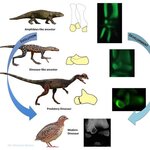
In the 19th century, Darwin’s most vocal scientific advocate was Thomas Henry Huxley, who is also remembered as a pioneer of the hypotheses that birds are living dinosaurs. He noticed several similarities of the skeleton of living birds and extinct dinosaurs, among them, a pointed portion of the anklebone projecting upwards onto the shank bone (aka drumstick).
This “ascending process” is well known to specialists as a unique trait of dinosaurs. However, until the late 20th century, many scientists were doubtful about the dinosaur-bird link. Some pointed out that the ascending process in most…

Just how bad was the bite of Tyrannosaurus rex? Pretty bad, because the feeding style and dietary preferences of dinosaurs was closely linked to how wide they could open their jaws and T. rex could open quite wide.
Using digital models and computer analyses, Dr. Stephan Lautenschlager from the University of Bristol studied the muscle strain during jaw opening of three different theropod dinosaurs with different dietary habits. Theropods (from the Greek for "beast-footed") were a diverse group of two-legged dinosaurs that included the largest carnivores ever to walk the Earth.
"…

When the largest modern-day plant-eaters, elephants, are in an area, they devastate the vegetation, like has happened in a South African nature reserve. So 15,000 years ago, when the herbivores like the Columbian mammoth, mastodons and giant ground sloths were even larger, more numerous and more widely distributed, and there were no dentists with high-powered rifles to take them down, how did the landscape survive?
The answer was probably enormous predators, creatures that biologists have called "hypercarnivores" and that the rest of the world just calls carnivores, or the circle of…

For years, evolutionary biologists have wondered how ecosystems during the Pleistocene epoch survived despite the presence of many species of huge, hungry herbivores, such as mammoths, mastodons and giant ground sloths.
Observations on modern elephants suggest that large concentrations of those animals could have essentially destroyed the environment, but that wasn't the case.
A new paper argues that the ecosystem was effectively saved by predatory animals that helped keep the population of large herbivores in check. Their findings show that intense, violent attacks by packs of some of the…
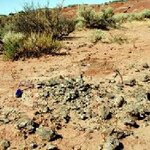
Were dinosaurs fast, aggressive hunters like those in the movie "Jurassic World", or did they have lower metabolic rates that made them more like today's alligators and crocodiles?
For 150 years, scientists have debated the nature of dinosaurs' body temperatures and how they influenced activity levels.
A new paper contends that some dinosaurs had the capacity to elevate their body temperatures using heat sources in the environment, such as the sun.
Credit: NSF
The researchers also believe the animals were probably more active than modern-day alligators and crocodiles,…
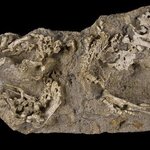
Scientists describe a perinatal group of Saurolophus angustirostris, a giant hadrosaur dinosaur, all likely from the same nest, found at the Dragon's Tomb in Mongolia, in a new study.
The Dragon's Tomb is a location famous for finding Late Cretaceous dinosaur fossils in the Gobi Desert, Mongolia, the authors of this study described three or four perinatal specimens or "babies" and two associated eggshell fragments. The young dinosaurs were likely part of a nest originally located on a river sandbank, and the authors suggest they are likely Saurolophus angustirostris (meaning 'lizard crest'),…

A 48 million year-old horse-like equoid fetus has been discovered at the Messel pit near Frankfurt, Germany according to a study in PLOS ONE.
Jens Lorenz Franzen from Senckenberg Research Institute Frankfurt, Germany, and Naturhistorisches Museum Basel, Switzerland, and colleagues completed their investigation of the fetus from a 48 million year-old horse-like equoid uncovered near Frankfurt, Germany in 2000. They evaluated the bones and anatomy and used scanning electronic microscopy (SEM) and high-resolution micro-x-ray to describe the ~12.5 cm fetus.
The fetus appears to be well-…
From trilobites to tyrannosaurs, most fossils are of creatures with hard shells or bones. These materials don’t easily biodegrade and sediment has time to build up around them and turn them into a record of the creature that is still with us millions of years after it has died. Soft-bodied organisms like worms, on the other hand, decay rapidly and their fossil record is decidedly patchy.
In exceptional circumstances, however, their remains are preserved and sometimes in the most unusual places. With the right detective skills, palaeontologists can use such discoveries to open up whole new…
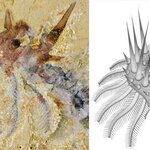
A new species of ‘super-armored’ worm, named Collinsium ciliosum, or Hairy Collins’ Monster after the palaeontologist Desmond Collins, who discovered and first illustrated a similar Canadian fossil in the 1980s, was a bizarre, spike-covered creature which ate by filtering nutrients out of seawater with its feather-like front legs, has been identified by palaeontologists.
The creature, which lived about half a billion years ago, was one of the first animals on Earth to develop armor to protect itself from predators and to use such a specialised mode of feeding.The creature,…
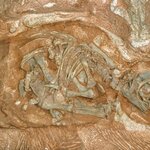
In the late winter of 1976, the world famous fossil collector James Kitching was doing a survey near South Africa’s border with Lesotho.
To his surprise he found a tiny clutch of six fossilized eggs along the side of the road at a place known as Rooidraai.
It took five years for skilled palentologists to remove enough rock matrix from the eggs so that they could be preliminarily identified as the first dinosaur embryos from South Africa and the oldest dinosaur embryos in the world.
Research on dinosaurs has truly blossomed in the 40 years since Kitching’s extraordinary find and a great deal…